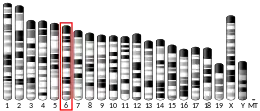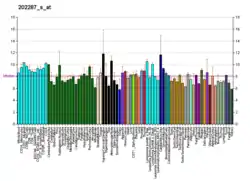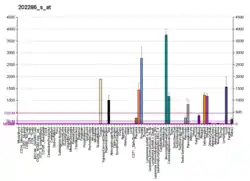TACSTD2
مبدل ۲ سیگنال کلسیمی وابسته به تومور (به انگلیسی: Tumor-associated calcium signal transducer 2) که با نامهای تروپ-۲ و آنتیژن گلیکوپروتئین ۱ اپیتلیومی (EGP-1) هم شناخته میشود،[4] یک پروتئین است که در انسان توسط ژن «TACSTD2» کُدگذاری میشود.[5][6][7]
این ژن فاقد اینترون است و یک آنتیژن مرتبط با کارسینوم میسازد پادتن تکتیرهٔ GA733 است که همچون یک گیرندهٔ سطح سلول عمل کرده و مبدل نوعی پیام درونسلولی کلسیمی است.
جهش در ژن «TACSTD2» سبب ایجاد بیماری ارثی «دیستروفی قطرهای شکل ژلاتینی قرنیه» میشود که نوعی بیماری اتوزومال مغلوب بوده و مشخصهاش آمیلوئیدوز شدید قرنیه است که منجر به نابینایی میگردد.[7]
این پروتئین هدف داروی سَـسیتوزومَـب گوویتیکان در درمان سرطان پستان سهگانه-منفی نیز هست.
منابع
- GRCm38: Ensembl release 89: ENSMUSG00000051397 - Ensembl, May 2017
- "Human PubMed Reference:". National Center for Biotechnology Information, U.S. National Library of Medicine.
- "Mouse PubMed Reference:". National Center for Biotechnology Information, U.S. National Library of Medicine.
- Immunomedics Awarded Fast Track Designation by FDA for Sacituzumab Govitecan (IMMU-132) for Triple-Negative Breast Cancer Therapy
- Linnenbach AJ, Seng BA, Wu S, Robbins S, Scollon M, Pyrc JJ, Druck T, Huebner K (Apr 1993). "Retroposition in a family of carcinoma-associated antigen genes". Mol Cell Biol. 13 (3): 1507–15. doi:10.1128/MCB.13.3.1507. PMC 359462. PMID 8382772.
- Calabrese G, Crescenzi C, Morizio E, Palka G, Guerra E, Alberti S (Apr 2001). "Assignment of TACSTD1 (alias TROP1, M4S1) to human chromosome 2p21 and refinement of mapping of TACSTD2 (alias TROP2, M1S1) to human chromosome 1p32 by in situ hybridization". Cytogenet Cell Genet. 92 (1–2): 164–5. doi:10.1159/000056891. PMID 11306819. S2CID 9708614.
- "Entrez Gene: TACSTD2 tumor-associated calcium signal transducer 2".
- مشارکتکنندگان ویکیپدیا. «TACSTD2». در دانشنامهٔ ویکیپدیای انگلیسی.
برای مطالعهٔ بیشتر
- Linnenbach AJ, Wojcierowski J, Wu SA, et al. (1989). "Sequence investigation of the major gastrointestinal tumor-associated antigen gene family, GA733". Proc. Natl. Acad. Sci. U.S.A. 86 (1): 27–31. Bibcode:1989PNAS...86...27L. doi:10.1073/pnas.86.1.27. PMC 286396. PMID 2911574.
- Fornaro M, Dell'Arciprete R, Stella M, et al. (1995). "Cloning of the gene encoding Trop-2, a cell-surface glycoprotein expressed by human carcinomas". Int. J. Cancer. 62 (5): 610–8. doi:10.1002/ijc.2910620520. PMID 7665234. S2CID 23260113.
- El Sewedy T, Fornaro M, Alberti S (1998). "Cloning of the murine TROP2 gene: conservation of a PIP2-binding sequence in the cytoplasmic domain of TROP-2". Int. J. Cancer. 75 (2): 324–30. doi:10.1002/(SICI)1097-0215(19980119)75:2<324::AID-IJC24>3.0.CO;2-B. PMID 9462726.
- Ripani E, Sacchetti A, Corda D, Alberti S (1998). "Human Trop-2 is a tumor-associated calcium signal transducer". Int. J. Cancer. 76 (5): 671–6. doi:10.1002/(SICI)1097-0215(19980529)76:5<671::AID-IJC10>3.0.CO;2-7. PMID 9610724.
- Tsujikawa M, Kurahashi H, Tanaka T, et al. (1999). "Identification of the gene responsible for gelatinous drop-like corneal dystrophy". Nat. Genet. 21 (4): 420–3. doi:10.1038/7759. PMID 10192395. S2CID 2275476.
- Nakamura T, Nishida K, Dota A, et al. (2000). "Gelatino-lattice corneal dystrophy: clinical features and mutational analysis". Am. J. Ophthalmol. 129 (5): 665–6. doi:10.1016/S0002-9394(00)00369-X. PMID 10844062.
- Kinoshita S, Nishida K, Dota A, Abbie F, et al. (2000). "Epithelial barrier function and ultrastructure of gelatinous drop-like corneal dystrophy". Cornea. 19 (4): 551–5. doi:10.1097/00003226-200007000-00029. PMID 10928776. S2CID 43011710.
- Tsujikawa M, Tsujikawa K, Maeda N, et al. (2000). "Rapid detection of M1S1 mutations by the protein truncation test". Invest. Ophthalmol. Vis. Sci. 41 (9): 2466–8. PMID 10937555.
- Ha NT, Fujiki K, Hotta Y, et al. (2000). "Q118X mutation of M1S1 gene caused gelatinous drop-like corneal dystrophy: the P501T of BIGH3 gene found in a family with gelatinous drop-like corneal dystrophy". Am. J. Ophthalmol. 130 (1): 119–20. doi:10.1016/S0002-9394(00)00596-1. PMID 11004271.
- Tasa G, Kals J, Muru K, et al. (2001). "A novel mutation in the M1S1 gene responsible for gelatinous droplike corneal dystrophy". Invest. Ophthalmol. Vis. Sci. 42 (12): 2762–4. PMID 11687514.
- Yoshida S, Kumano Y, Yoshida A, et al. (2002). "Two brothers with gelatinous drop-like dystrophy at different stages of the disease: role of mutational analysis". Am. J. Ophthalmol. 133 (6): 830–2. doi:10.1016/S0002-9394(02)01407-1. PMID 12036680.
- Ren Z, Lin PY, Klintworth GK, et al. (2002). "Allelic and locus heterogeneity in autosomal recessive gelatinous drop-like corneal dystrophy". Hum. Genet. 110 (6): 568–77. doi:10.1007/s00439-002-0729-z. PMID 12107443. S2CID 24052349.
- Strausberg RL, Feingold EA, Grouse LH, et al. (2003). "Generation and initial analysis of more than 15,000 full-length human and mouse cDNA sequences". Proc. Natl. Acad. Sci. U.S.A. 99 (26): 16899–903. doi:10.1073/pnas.242603899. PMC 139241. PMID 12477932.
- Ha NT, Chau HM, Cung le X, et al. (2003). "A novel mutation of M1S1 gene found in a Vietnamese patient with gelatinous droplike corneal dystrophy". Am. J. Ophthalmol. 135 (3): 390–3. doi:10.1016/S0002-9394(02)01952-9. PMID 12614764.
- Gires O, Eskofier S, Lang S, et al. (2003). "Cloning and characterisation of a 1.1 kb fragment of the carcinoma-associated epithelial cell adhesion molecule promoter". Anticancer Res. 23 (4): 3255–61. PMID 12926061.
- Tian X, Fujiki K, Li Q, et al. (2004). "Compound heterozygous mutations of M1S1 gene in gelatinous droplike corneal dystrophy". Am. J. Ophthalmol. 137 (3): 567–9. doi:10.1016/j.ajo.2003.08.008. PMID 15013888.
- Murakami A, Kimura S, Fujiki K, et al. (2004). "Mutations in the membrane component, chromosome 1, surface marker 1 (M1S1) gene in gelatinous drop-like corneal dystrophy". Jpn. J. Ophthalmol. 48 (4): 317–20. doi:10.1007/s10384-003-0064-5. PMID 15295654. S2CID 28358081.
- Gerhard DS, Wagner L, Feingold EA, et al. (2004). "The status, quality, and expansion of the NIH full-length cDNA project: the Mammalian Gene Collection (MGC)". Genome Res. 14 (10B): 2121–7. doi:10.1101/gr.2596504. PMC 528928. PMID 15489334.
This article is issued from Wikipedia. The text is licensed under Creative Commons - Attribution - Sharealike. Additional terms may apply for the media files.



